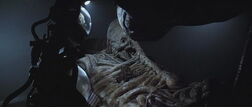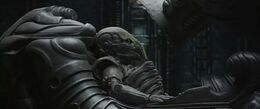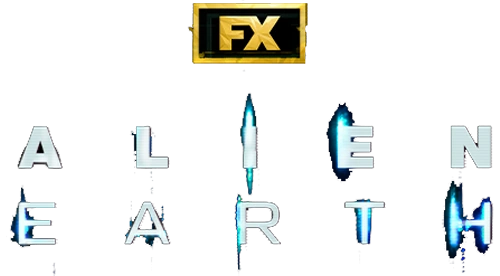Template:Creature The Engineers are an humanoid ancient extraterrestrial race of unknown origin.
Name
The name "Engineer" was given by Elizabeth Shaw and Charlie Holloway due to the lifeform being responsible for "engineering" the human race. Before the release of Prometheus, the Engineers were originally dubbed as the "Space Jockeys". The nickname was attached to it during production on Alien. Scott has stated he has no idea who christened the creature. People needed something to call this creature, and somehow Space Jockey stuck. But the creature has also had a host of other names including The Pilot (Giger's original nickname for it), Pilots, James Cameron called it the "Big Dental Patient," and later in the novel Aliens: Original Sin as Mala'kaks. Their "scientific" name is "Mundus gubernavi" (Universal Pilot).
Appearance
The Engineers are extremely pale, hairless and humanoid, with two arms and legs, and said to have staring, "dead seeming" eyes. The veins underneath their skin are visible, and their pupils are in the shape of oblong plus-symbols.
The Engineers are 8-9 feet tall and breathe oxygen just like human beings but are also able to survive on LV-223′s surface. They are also extremely strong given the fact that one Engineer killed Peter Weyland's escorts by sending them flying across the room from simple punches.
History
Little is known about the Engineers' history, but the Engineers are shown to be the "creators" of the human race as they visited Earth during its primordial state, whereupon a lone "Engineer" ingests an unknown substance, causing his entire body structure to dissolve and seeding the planet with his DNA, and hastening evolution upon that world. The Engineers continue to visit Earth multiple times to secretly observe the human race's development.
At some point approximately 2,000 years before, the Engineers stationed on LV-223 initiated a plan to wipe out humanity for reasons unknown by releasing a pathogen they had created. However, they apparently lost control of the pathogen and led the Engineers there to die off. Four surviving Engineers took refuge within their ship stored themselves within their ship's Hypersleep Chambers, only one of them survived.
In 2089, archeologists Elizabeth Shaw and Charlie Holloway discover a star map among several unconnected ancient cultures within a cave during their expedition on the Isle of Skye. They interpret this as an invitation from the Engineers. Shaw then contacted Peter Weyland, the elderly CEO of Weyland Corporation, for a proposal in order to gain enough funding for an expedition to follow the star map. Weyland agrees with the proposal and funds the creation of the scientific vessel Prometheus to follow the map to the distant moon LV-223.
In 2093, after the Prometheus' two year voyage, the ship arrived on LV-223. The Prometheus crew explored the moon's surface where they came across the Engineer's structure. The crew entered the structure and discovered the bodies of some Engineers, as well as several "urns" stored within the structure. The crew's interference caused the pathogen stored within the "urns" to melt, A few crew members were exposed to the pathogen, and in the ensuing chaos most were killed. The android David successfully found the last living Engineer and informed Weyland, who was secretly aboard the ship the entire time. Weyland and his team went to the Engineers' ship to commune with the last Engineer however, upon waking; the Engineer decapitated David after a brief conversation and killed Weyland along with the entire party, save Shaw, who managed to escape.
The Engineer reactivated his ship and headed for Earth to carry out his original mission to wipe out the human race. The remaining crew later sacrificed themselves and the Prometheus to destroy the Engineer's ship. The Engineer survived and attacked Shaw within Prometheus' lifeboat, Shaw released the Trilobite she had extracted earlier from her womb as the result of intercourse with Holloway, who was infected by the pathogen, which restrains and impregnates the Engineer while Shaw escapes. The Engineer later died and birthed a Proto Alien.

The fossilized corpse of an Engineer in The Derelict.
Morphoology The Book of Alien notes that the actors and crew felt instinctively that the Space Jockey was a benign creature, though they could not say why. In the novelisation of Alien by Alan Dean Foster, Ash describes the Space Jockey's race as a noble people and hopes that mankind will encounter them under more pleasant circumstances. It also states that they were larger, stronger and possibly more intelligent than humans. The first Space Jockey was seen in the original Alien movie as a giant humanoid corpse sitting in front of a telescope-like device aboard the derelict craft. It had been there for an extremely long time, long enough for the corpse to become fossilized. The Jockey that the starship Nostromo's crew found aboard the derelict seemed to be growing out of the chair of the telescope, as if it had fused itself into it. Its rib cage was bent outward; it is evident that a Xenomorph escaped from the creature, though no adult Xenomorphs were encountered on the derelict. It is mostly likely any adult xenomorph would have been dead by the time the derelict was discovered due to the lack of food sources although the Xenomorph eggs, we learned, can survive for at least 57 years (as was Ripley's long hypersleep) and the facehuggers inside are probably in some kind of statis until contact.
In the comics, the Jockey is shown to have an elephantine trunk. This is inconsistent with the original concept. An inspection of the concept art done by H.R. Giger, shows that the "trunk" is supposed to be an air hose and there is a helmet surrounding the Jockey's head. Tploopyhis is also supported by the fact that soft tissue such as elephant trunks do not fossilize. This does not leave out the possibility of a different kind of trunk, but the one depicted in the comics is very much like an elephant's. None of the works depicting the Jockey with a "trunk" are considered canon - the only canon appearance of the Space Jockey is in Alien and its novelisation and directly related works.
In an early script visualized but never written, the Pilot ship had crashed or landed on LV-426 some 10 million years prior to discovery by the Nostromo. It was depicted as having been dragged in some unknown manner to the top of a pyramidal structure, which was the top of an enormous subterranean temple containing the Xenomorph eggs. This is evident in the finished Alien film, when Kane notices the hole torn in the bottom of the Pilot ship. It should also be noted that despite later rewrites and storylines, Giger and O'Bannon designed the Pilot so that it appeared to be a sympathetic and friendly lifeform.
However Ridley Scott also said the creature was a suit rather than a biomechanical lifeform. It's "Trunk" was actually an air hose for breathing. In the movie Prometheus, it turns out the creature in the chair was actually in a flight suit. The creature's uniform has retractable sleeves and helmet to presumably filter out the environment for it. When the black liquid attacked them, they all seemed to wear the suits to protect themselves.Their true form is almost similar to humans except that they do not grow hair, they are a pale white, their eyes are almost completely black, they are taller, they are smarter, and they have increased strength.
Culture
Though not much is known about the Engineers, it is shown that the Engineers have displayed advanced forms of culture that exist within their society, such as language, visual arts, music and clothing.
The Engineers' writing system is strikingly similar to Mesopotamian cuneiform that can be found in the middle-east, and their hieroglyphs are identical to what is found in Egypt, Mesoamerica, and other places on Earth.
Technology

An Engineer in spacesuit
The Engineers are a technologically-advanced race of creatures. They are extremely advanced in genetic engineering and have built their own spacecraft.
The cargo hold of the Space Jockey's ship was filled with eggs of Xenomorphs (the first stage in the Xenomorph life cycle), which were held in stasis beneath a blue electrical mist. It has been speculated by fans that the Space Jockey's race are the creators of the xenomorphs because of the similarities in design between the spacecraft and the biomechanical xenomorphs.
The novelization by Alan Dean Foster, on the other hand, states that Space Jockey's race found them on LV-426, and there has been no conclusive evidence shown in the feature film series supporting that the Space Jockey's race created the xenomorph. Clearly, however, the Space Jockey's race have advanced technology, leaving open the possibility that they had a hand in the Xenomorph's creation. The image of a Xenomorph on the wall of a room inside the structure on LV-223 suggests that the birth of The Deacon at the end of the film is not the very first Xenomorph.
Director Ridley Scott also makes note that he would like to make "an Alien 5 or Alien 6" where the audience would be privy to the home planet of the Xenomorphs and learn more about the Space Jockeys, but makes no reference to whether this is the same planet that the Space Jockey's race hails from.
While exploring the interior of the Engineer-constructed spacecraft, Juggernaut, David observed a type of slime with an energy inside that was used to press buttons, activate doors, and objects. Also show there was one Engineer alive in a form of stasis similar to that used by Humans. Engineers were capable of holograms, terraforming atmospheres, flying, bio-engineering, and perhaps even accelerating evolution.
Appearances
The only two movies that the Space Jockey pilot itself has featured in is the original 1979 Alien and the prequel Prometheus. Swiss surrealist artist H. R. Giger was hired on the movie Alien to design the title's creature and the environment of the alien planet. The Space Jockey was one of many things he created for the film. The scene inside the derelict's interior with the Jockey pilot was, according to the writers, an essential scene, although the Fox production company wanted to pull it from the movie for cost reasons. Eventually the filmmakers won and the scene was filmed, the Space Jockey and interior being built full-scale by Giger. The Space Jockey prop was 26 feet (7.9 m) tall. A smaller version of the prop was also built, but was destroyed by arsonists while on display at the Egyptian Theater in Hollywood. A second casting of the prop was destroyed for unknown reasons while still in the original mold. Pieces of this cast are owned by an anonymous collector in Moorpark, California. A third, partial casting, still exists intact. It is also owned by the same anonymous collector. However, the third cast was not an original production cast, but it is the last known authentic casting from the original mold. The mold itself is owned by an anonymous collector in the San Fernando Valley, in Southern California.
The Space Jockey's race has not appeared or been referred to in any of the subsequent films, but have been featured prominently in many of the videogames, Alien books, and comics series. They have made appearances in various Aliens comics by Dark Horse Comics. In the bonus materials of the special edition Alien DVD, director Ridley Scott has expressed the opinion that a film exploring the backstory of the Space Jockey would be an interesting new direction for the series to take. To follow his opinion he has directed the prequel to Alien, Prometheus.
In Mark Verheiden's graphic novel series Aliens, a Space Jockey-like creature is encountered, and is able to communicate telepathically with humans. It is shown with pink skin, a tail and an elephantine trunk, and yellow, cross-shaped eyes. In the novels the Space Jockey's race are shown to be malevolent, only refraining from attacking humans due to their immense hatred of the Xenomorphs; a common enemy. They intend to wipe out and/or enslave humanity once their war with the Xenomorphs is over. Later books never expand on the idea.
In the more recent book, Aliens: Original Sin, the Space Jockeys are mentioned and discussed throughout the book. Towards the end it is revealed that they are trying to breed a group of Aliens.
Trivia
- The Book of Alien notes that the actors and crew felt instinctively that the Space Jockey was a benign creature, though they could not say why.
- In the novelization of Alien by Alan Dean Foster, Ash describes the Space Jockey's race as a noble people and hopes that mankind will encounter them under more pleasant circumstances.
- In an early script visualized but never written, the Pilot ship had crashed or landed on LV-426 some 10 million years prior to discovery by the Nostromo. It was depicted as having been dragged in some unknown manner to the top of a pyramidal structure, which was the top of an enormous subterranean temple containing the Xenomorph eggs. This is evident in the finished Alien film, when Kane notices the hole torn in the bottom of the Pilot ship. It should also be noted that despite later rewrites and storylines, Giger and O'Bannon designed the Pilot so that it appeared to be a sympathetic and friendly lifeform.
